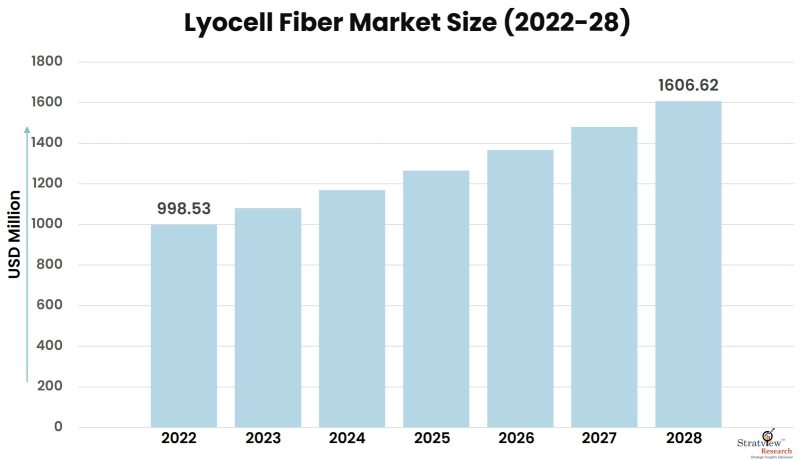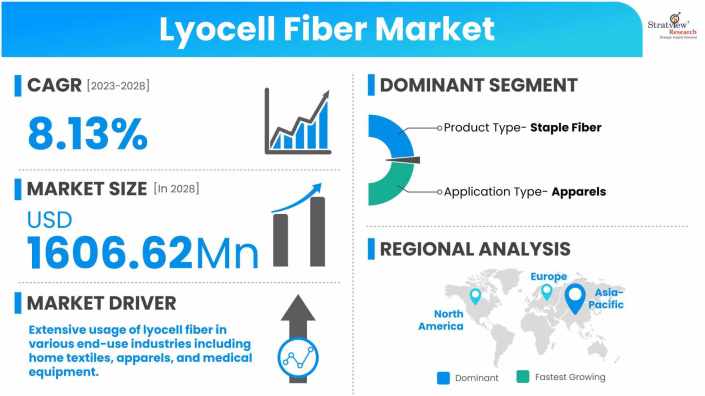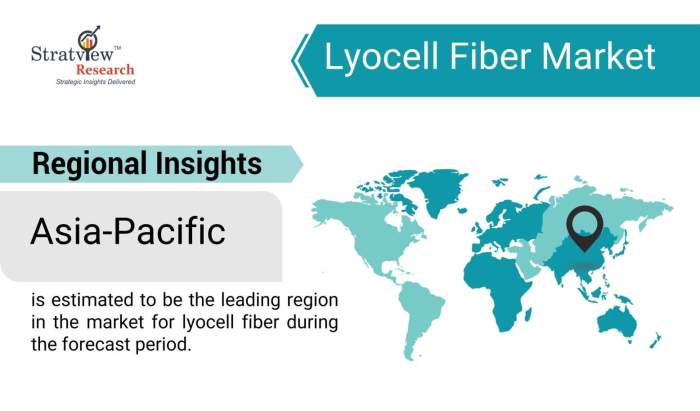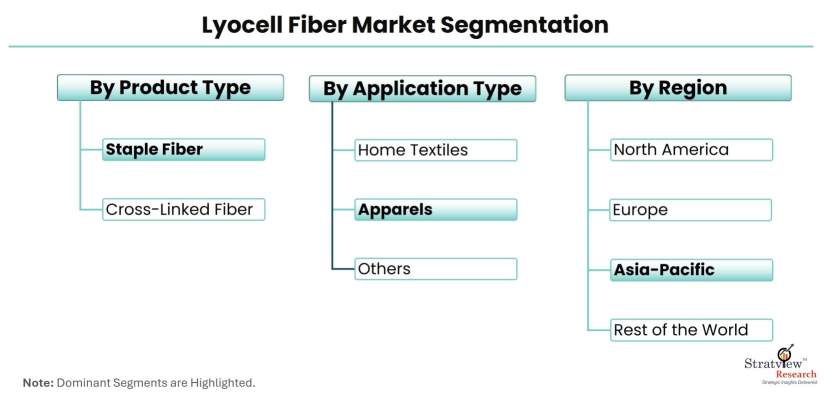Market Insights
The lyocell fiber market was estimated at USD 998.53 million in 2022 and is likely to grow at a CAGR of 8.13% during 2023-2028 to reach USD 1606.62 million in 2028.

Want to know more about the market scope? Click Here
Market Dynamics
Introduction
Lyocell fiber, also known as lyocell, is a cellulose-based fiber with a unique manufacturing method, softness, strength, and adaptability. It is widely used in the textile sector for various garments and textile items due to its biodegradability and sustainable nature. Lyocell is a significant player in the global textile industry, transforming traditional fabric manufacturing and consumption.
The fiber is made from natural cellulose, primarily from wood pulp, and is produced through solvent spinning technology. The solvent dissolves the cellulose, resulting in filaments that are then consolidated and spun into fibers using a coagulation bath. The closed-loop system of the process reduces waste and environmental effects.
Lyocell's soft and smooth texture makes it appealing in apparel, bed linens, and home textiles. The circular cross-section and homogeneous surface of the fibers provide a silky sensation, making it soothing on the skin and pleasant to wear. The absence of projecting fibers reduces discomfort and improves the overall tactile feel.
Lyocell fiber's durability is another key feature. Its high tensile strength allows it to tolerate significant stretching and tugging without losing its integrity, promoting product life and sustainability through lower consumption.
Market Drivers
Key factors driving the growth of the lyocell fiber market are:
- Extensive usage of lyocell fiber in various end-use industries including home textiles, apparels, and medical equipment.
- Furthermore, rapid development in the healthcare industry and growing awareness of using sterilized products along with the growing popularity of biodegradable fibers.

Want to have closer look in this market report? Click Here
Opportunities
The lyocell fiber market is gaining popularity due to its sustainability, comfort, and versatility, offering numerous opportunities for businesses and investors.
- Surge in Demand for Sustainable Textiles: Consumers are increasingly concerned about the environmental impact of their clothing choices, making Lyocell a compelling alternative to traditional synthetic fibers like polyester.
- Expansion of Application Range: Lyocell's versatile properties make it ideal for various applications, including home textiles, hygiene products, medical textiles, and non-woven materials beyond apparel.
- Technological Developments: Research and development are enhancing production efficiency, reducing costs, and creating new Lyocell variants with enhanced functionalities like fire resistance or moisture management.
- Support from Government: Governments are promoting sustainable materials like Lyocell through policies and initiatives, offering financial incentives and market access for producers and manufacturers.
Challenges
The lyocell fiber market, despite its promising outlook, is facing several challenges that require immediate attention for sustained growth:
- Higher Production Costs: Lyocell production remains expensive compared to traditional fibers like cotton and polyester, potentially limiting its affordability and hindering wider adoption in cost-sensitive markets.
- Geopolitical Concerns: Trade tensions and supply chain disruptions can impact the availability and cost of raw materials like wood pulp, affecting Lyocell production and market stability.
- Competitive Environment: Lyocell faces competition from sustainable fibers like bamboo and hemp, necessitating innovation and differentiation to maintain its competitive edge.
Restraints
The lyocell fiber market's growth may be hindered by certain factors, necessitating careful analysis and the implementation of mitigation strategies:
- Land Use and Deforestation: Lyocell's large-scale wood pulp production raises deforestation and unsustainable land-use concerns, necessitating sustainable forestry practices and certified wood pulp sourcing to mitigate these issues.
- Water Usage and Chemical Emissions: Lyocell production, despite its closed-loop system, still causes more water consumption and chemical emissions, necessitating continuous process optimization and the adoption of cleaner technologies to minimize environmental impact.
- Recycling Infrastructure: Lyocell's recycling infrastructure is still in its early stages, necessitating the development of efficient systems to improve its sustainability credentials.
Segments Analysis
|
Segmentations
|
List of Sub-Segments
|
Dominant and Fastest-Growing Segments
|
|
Product-Type Analysis
|
Staple Fiber and Cross-linked Fiber
|
Staple fiber is expected to witness significant growth in the market over the projected period.
|
|
Application-Type Analysis
|
Apparels, Home Textiles, Surgical Products, Baby Diapers, Automotive Filters, and Others
|
Apparels are estimated to be the dominating segment of the market during the forecast period.
|
|
Regional Analysis
|
North America, Europe, Asia-Pacific, and Rest of the World
|
Asia-Pacific is estimated to be the leading region in the market for lyocell fiber during the forecast period.
|
By Product Type
"The staple fiber segment accounted for the largest market share."
The market is segmented as staple fiber and cross-linked fiber. Staple fiber is expected to witness significant growth in the market over the projected period. The growth of the segment is attributed to its various applications in denims, towels, and casual wear.
By Application Type
"The apparels segment accounted for the largest market share."
The market is segmented as apparels, home textiles, surgical products, baby diapers, automotive filters, and others. Apparels are estimated to be the dominating segment of the market during the forecast period on account of their favourable characteristics such as softness and absorbent qualities. On the other hand, home textile is expected to witness significant growth in the market owing to its various applications in medical accessories such as absorbent pads, compression bandages, wound-contact layer, gauze dressing and wipes used in operation theatre.
Regional Insights
"Asia-Pacific accounted for the largest market share."
Asia-Pacific is estimated to be the leading region in the market for lyocell fiber during the forecast period. The region’s growth is driven by the growing textile and apparel industries along with improved standard of living in the region. North America and Europe are also estimated to witness significant growth in the market over the projected period. On account of the presence of numerous textile and apparel industry players in the respective regions.

Know the high-growth countries in this report, Register Here
Key Players
The following are the key players in the market.
Note: The above list does not necessarily include all the top players in the market.
Are you the leading player in this market? We would love to include your name. Write to us at sales@stratviewresearch.com
Research Methodology
This strategic assessment report, from Stratview Research, provides a comprehensive analysis that reflects today’s lyocell fiber market realities and future market possibilities for the forecast period. The report segments and analyzes the market in the most detailed manner in order to provide a panoramic view of the market. The vital data/information provided in the report can play a crucial role for the market participants as well as investors in the identification of the low-hanging fruits available in the market as well as to formulate the growth strategies to expedite their growth process.
This report offers high-quality insights and is the outcome of a detailed research methodology comprising extensive secondary research, rigorous primary interviews with industry stakeholders, and validation and triangulation with Stratview Research’s internal database and statistical tools. More than 1000 authenticated secondary sources, such as company annual reports, fact books, press releases, journals, investor presentations, white papers, patents, and articles, have been leveraged to gather the data. We conducted more than 15 detailed primary interviews with the market players across the value chain in all four regions and industry experts to obtain both qualitative and quantitative insights.
Report Features
This report provides market intelligence in the most comprehensive way. The report structure has been kept such that it offers maximum business value. It provides critical insights into market dynamics and will enable strategic decision-making for existing market players as well as those willing to enter the market. The following are the key features of the report:
- Market structure: Overview, industry life cycle analysis, supply chain analysis.
- Market environment analysis: Growth drivers and constraints, Porter’s five forces analysis, SWOT analysis.
- Market trend and forecast analysis.
- Market segment trend and forecast.
- Competitive landscape and dynamics: Market share, Service portfolio, New Product Launches, etc.
- COVID-19 impact and its recovery curve
- Attractive market segments and associated growth opportunities.
- Emerging trends.
- Strategic growth opportunities for the existing and new players.
- Key success factors.
Market Segmentation
This report studies the market, covering a period of 12 years of trend and forecast. The report provides detailed insights into the market dynamics to enable informed business decision-making and growth strategy formulation based on the opportunities present in the market.
The lyocell fiber market is segmented into the following categories.
By Product Type
- Staple Fiber
- Cross-linked Fiber
By Application Type
- Apparels
- Home Textiles
- Surgical Products
- Baby Diapers
- Automotive Filters
- Others
By Region
- North America (Country Analysis: the USA, Canada, and Mexico)
- Europe (Country Analysis: Germany, France, the UK, Russia, Spain, and the Rest of Europe)
- Asia-Pacific (Country Analysis: China, Japan, India, South Korea, and the Rest of Asia-Pacific)
- Rest of the World (Sub-Region Analysis: Latin America, the Middle East, and Others)

Click here to learn the market segmentation details.
Report Customization Options
Stratview Research offers one of the following free customization options to our respectable clients:
Company Profiling
- Detailed profiling of additional market players (up to 3 players).
- SWOT analysis of key players (up to 3 players).
Competitive Benchmarking
- Benchmarking of key players on the following parameters: Product portfolio, geographical reach, regional presence, and strategic alliances.
Custom Research: Stratview Research offers custom research services across sectors. In case of any custom research requirement related to market assessment, competitive benchmarking, sourcing and procurement, target screening, and others, please send your inquiry at sales@stratviewresearch.com.

